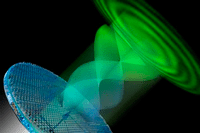Electronics News
Archive : 6 November 2017 год
 Arduino has released a set of new features for its Create Cloud platform aimed at expanding the number of Arduino supported platforms for the development of IoT applications.
Arduino has released a set of new features for its Create Cloud platform aimed at expanding the number of Arduino supported platforms for the development of IoT applications.
Following this release Arduino Create Cloud users will now be able to programme Linux boards as if they were regular Arduino boards. Multiple Arduino programmes can run simultaneously on a Linux based board and programmes can communicate with each other by leveraging the Arduino Connector.
Arduino Create Cloud will enable users to manage individual IoT devices and programme them remotely, independently from where they are located.
Arduino has also developed an out-of-the-box experience, which enables anybody to set up a new device from scratch from the cloud without any previous knowledge by following an intuitive web based wizard.
The initial release has been sponsored by Intel and supports X86/X86_64 boards. As a reference implementation, a simplified user experience has been designed for the AAEON UP board, although other platforms are already supported by the Arduino Create Cloud platform (Intel NUC, Dell Wyse, Gigabyte GB-BXT).
Arduino plans to expand support for Linux based IoT devices running on other hardware architectures in the upcoming months.
“With this release Arduino extends its reach into Edge Computing, enabling anybody with Arduino programming experience to develop complex IoT applications on gateways. This is an important step forward in democratising access to the professional Internet of Things,” said Massimo Banzi, Arduino CTO.
Author
Neil Tyler
Source: www.newelectronics.co.uk
 Structured beams of light which exhibit strange behaviour could have such applications as super-resolution imaging and communications, according to researchers the Harvard School of Engineering and Applied Sciences, who have have developed a tool to generate new states of light in a different way.
Structured beams of light which exhibit strange behaviour could have such applications as super-resolution imaging and communications, according to researchers the Harvard School of Engineering and Applied Sciences, who have have developed a tool to generate new states of light in a different way.
“We have developed a metasurface; a new tool to study novel aspects of light,” said Professor Federico Capasso. “This optical component makes possible much more complex operations and allows researchers to not only explore new states of light, but also new applications for structured light.”
The metasurface is said to connect two aspects of light: orbital angular momentum; and circular polarisation, or spin angular momentum.
While the fact that light can carry orbital momentum is said by the team to be a relatively recent discovery, it’s this property which enables beams in the shape of corkscrews. Previous research has used polarisation to control the size and shape of beams, but the connection was limited because only certain polarisations could convert to certain orbital momentums.
“This metasurface gives the most general connection, through a single device, between the orbital momentum and polarisation of light that’s been achieved so far,” said researcher Robert Devlin.
The device can be designed so that any input polarisation of light can result in any orbital angular momentum output. This means any polarisation can yield any kind of structured light – such as spirals, corkscrews and vortices of any size. The device can also be programmed so that one polarisation results in one vortex and a different polarisation results in a completely different vortex.
Alongside high-powered imaging, the development could find application in free space optical communication, especially in scattering environments. It has also been shown that similar elements could be incorporated into lasers. “This may lead to unforeseen applications,” said researcher Noah Rubin.
Author
Graham Pitcher
Source: www.newelectronics.co.uk
Researchers at Chalmers University of Technology have developed a flexible detector for terahertz frequencies which features graphene transistors on plastic substrates.
The device, said to be the first of its kind, has the potential to extend the use of terahertz technology to applications that will require flexible electronics, such as wireless sensor networks and wearable technology. At room temperature, the device can detect frequencies ranging from 330 to 500GHz.
One challenge has been the need to develop a process that enables the creation of low weight and cheap applications. While advances in polymer technology have promoted the development of flexible electronics and enabled the production of high frequency units on flexible substrates, Chalmers researchers Xinxin Yang, Andrei Vorobiev, Andrey Generalov, Michael Andersson and Jan Stake have now developed a mechanically flexible graphene-based terahertz detector.
Translucent and flexible, the process is said to be suitable for a variety of applications, including THz imaging and a sensor for identifying different substances.
Author
Graham Pitcher
Source: www.newelectronics.co.uk
 An agreement between SiFive and Flex Logix will see the latter’s EFLX embedded FPGA technology available for use in the SiFive Freedom Platform as part of the DesignShare programme. According to the partners, this will reduce time to market and remove some of the barriers that have blocked smaller companies from developing custom silicon.
An agreement between SiFive and Flex Logix will see the latter’s EFLX embedded FPGA technology available for use in the SiFive Freedom Platform as part of the DesignShare programme. According to the partners, this will reduce time to market and remove some of the barriers that have blocked smaller companies from developing custom silicon.
“There is a critical need in the chip industry to provide a faster, cheaper way for innovative companies to rapidly prototype new, advanced chip architectures,” said Geoff Tate, Flex Logix’ CEO. “Through DesignShare, SiFive and Flex Logix can give customers a programmable, flexible chip design for both microcontroller SoCs and multicore process SoCs.”
Unlike traditional ASIC models, SiFive’s Freedom Platform and its DesignShare partners reduce the investment cost associated with custom silicon and streamline the IP acquisition process. In this way, the programme aims to increase the number of new silicon designs starts significantly.
“The addition of Flex Logix’ embedded FPGA platform to the DesignShare ecosystem provides engineers with a new and better way to bring SoCs to market,” said SiFive’s CEO Naveed Sherwani. " DesignShare will make it easier and more flexible for designers to employ RISC-V across a wide range of implementations, from embedded devices to the data centre.”
SiFive will make the EFLX embedded FPGA technology available at the 28nm and 180nm nodes, with several embedded FPGA array size options available for each node. The EFLX embedded FPGA also will be integrated into a future tape-out of the SiFive U500 base platform for customer evaluation using SiFive evaluation boards and software.
Author
Graham Pitcher
Source: www.newelectronics.co.uk

